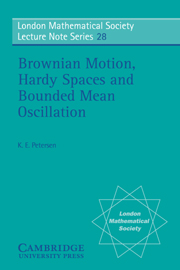Book contents
- Frontmatter
- Contents
- Preface
- 1 Introduction
- 2 The maximal, square and Littlewood-Paley functions
- 3 Brownian motion
- 4 Distribution equivalence of the two maximal functions
- 5 Inequalities for the conjugate function
- 6 The maximal function characterization of Hp
- 7 The martingale versions of HP and BMO
- References
- Index
- Frontmatter
- Contents
- Preface
- 1 Introduction
- 2 The maximal, square and Littlewood-Paley functions
- 3 Brownian motion
- 4 Distribution equivalence of the two maximal functions
- 5 Inequalities for the conjugate function
- 6 The maximal function characterization of Hp
- 7 The martingale versions of HP and BMO
- References
- Index
Summary
In 1915 G. H. Hardy, answering a question of Bohr and Landau, investigated properties of the mean over a circle of the modulus |F| of an analytic function F which were similar to those of the maximum value of |F| over a disk. He found that his results applied also to |F|P for p < 0, and thus was founded the theory of HP spaces. Since then these Hardy spaces have been the object of much research, and their connections with such diverse subjects as classical function theory (especially the boundary behavior of analytic functions), potential theory (including the theory of harmonic functions and partial differential equations), Fourier series, functional analysis, and operator theory (for example Beurling's work on invariant subspaces of the shift operator) have been developed in considerable detail.
An entirely new line of investigation for the Hardy spaces was uncovered in 1971 by Burkholder, Gundy, and Silverstein when they showed that for 0 < p < ∞ an analytic function F = u + iũ is in HP if and only if the maximal function of u is in LP. Surprisingly, their arguments were probabilistic in nature, being carried out by manipulation of Brownian motion in the complex plane. Their result showed that the Hardy spaces could be characterized in real-variable terms and thus Hp theory could be easily extended to higher dimensions and more general kinds of spaces.
Information
- Type
- Chapter
- Information
- Publisher: Cambridge University PressPrint publication year: 1977
